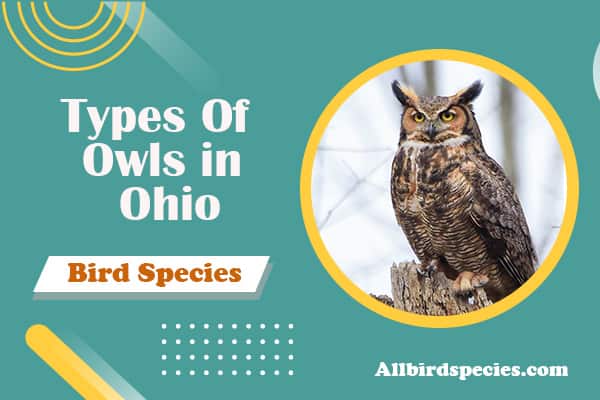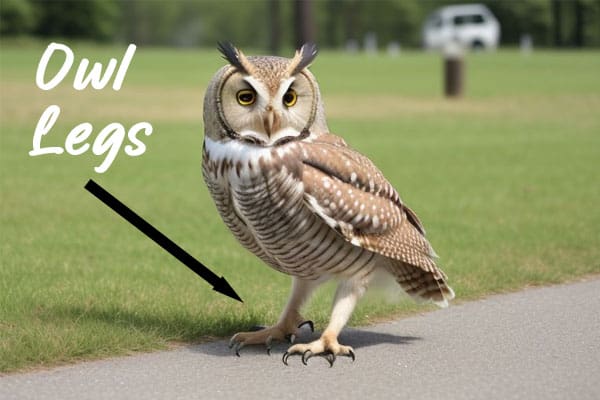8 Types of Owls in Ohio (ID Guide With Photos)
Ever wondered why owls are so fascinating, especially in Ohio? As you start to learn about the owl species in this state, you’ll find a world full of diversity. This guide will show you the eight main owls in Ohio. Each one has special traits and plays a key role in nature.
Owls in Ohio are amazing, known for their silent flight and eerie calls. They are crucial for keeping ecosystems balanced. Whether you love birds or are new to wildlife, learning about these owls will make you appreciate nature more.
~Learn about the different Types of Owls in Ohio~
Ohio is home to many owl species, making it a great place for bird lovers. These birds can be found in various places, from deep forests to city neighborhoods. This shows how adaptable they are.
Ohio’s Owl Diversity
Ohio has eight owl species, each with its habits and homes. Some live here all year, while others visit during certain seasons. From the tiny Eastern screech owl to the big Great Horned Owl, they all play a key role in keeping the ecosystem balanced.
Importance of Owls in Ecosystems
Owls are important because they control the numbers of small mammals and insects. This helps keep their habitats healthy. They act as indicators of the environment’s health. This means we need to protect owls and their homes to keep our ecosystems balanced.
Characteristics of Ohio Owls
Owls are amazing birds with unique traits. They have special physical features and behaviors that help them live in different places. Learning about these traits makes it easier to spot owls and understand their lives.
Physical Attributes and Adaptations
Owls have special ears that help them hear very well. These ears are placed on both sides of their head, letting them catch even the faint sounds from their prey. Their big eyes are right in front, perfect for seeing in the dark.
Their feathers are made in a way that lets them fly quietly. This helps them sneak up on their prey. Owls come in all sizes, fitting into various habitats.
Behavioral Traits of Owls
Owls are mostly active at night, which is why they’re so good at hunting in the dark. They have different ways of hunting, like waiting quietly or flying silently to catch their food. Their sharp senses help them find what they need.
They also make sounds to talk to each other, especially when they’re looking for a mate. These sounds can be soft or loud, helping them mark their territory and find a partner.
1. Eastern Screech-Owl
The Eastern Screech-Owl is a charming owl found in Ohio. It’s easy to spot because of its unique features and flexible lifestyle. Learning about its identification features, habitat, and diet will help you appreciate it more.

Identification Features
The Eastern Screech-Owl is small, about 8.5 inches tall with a 20-inch wingspan. It has tufted ears and bright yellow or amber eyes. Its feathers can be gray, reddish-brown, or other colors. It makes soft whistles, which helps identify it.
Habitat and Distribution
This owl lives in woods, parks, and even cities. It likes to nest in tree holes or nest boxes. You can find them all over Ohio, in both wooded and suburban areas.
Diet and Feeding Habits
The Eastern Screech-Owl eats a mix of small mammals, insects, and fruits. It’s an opportunistic feeder, changing its diet based on what’s available. Watching it eat shows how it can adapt to different places.
| Feature | Description |
|---|---|
| Owl Size | Approximately 8.5 inches in height; wingspan of 20 inches |
| Plumage | Varies from gray to reddish-brown, with distinctive ear tufts |
| Habitat | Wooded areas, parks, urban environments |
| Nesting Locations | Tree cavities, man-made nest boxes |
| Geographical Range | Widespread across Ohio |
| Diet | Small mammals, insects, fruits |
| Feeding Behavior | Opportunistic; varies based on available prey |
2. Great Horned Owls in Ohio
The Great Horned Owl is a standout in Ohio’s wildlife, known for its unique traits. It’s easily spotted by its tufted “ears” and bright yellow eyes. This bird is big and has a look that grabs attention.

Distinctive Traits
This owl can grow up to 22 inches long and has a wingspan of 44 inches. Its appearance is striking, with mottled gray and brown feathers that blend into its surroundings. They have strong talons perfect for quick and precise hunting moves.
Nesting Preferences
Great Horned Owls don’t build their own nests. They use old nests from bigger birds or find tree cavities and other spots for nesting sites. They often pick cliffs or man-made structures for a safe place to raise their young.
Hunting Techniques
The Great Horned Owl hunting is both versatile and skilled. As a top predator, it eats small mammals and birds. Its great hearing and vision help it find prey at night. With its strong talons, it makes quick and efficient catches.
3. American Barn Owl
The American Barn Owl is a fascinating bird with distinct features and a big role in nature. It stands out because of its unique look and where it lives. These traits help it play a key part in the ecosystem.
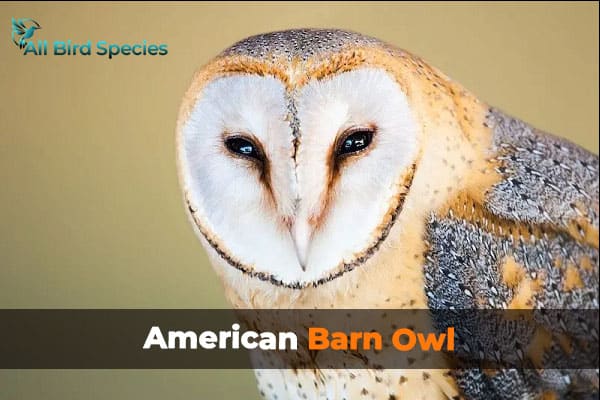
Physical Description
This owl has a heart-shaped face that catches the eye. It measures 12.5 to 16 inches long and weighs between 14 and 24.7 ounces. Its feathers are mostly pale with soft textures, but it has dark spots for hiding. This mix of looks makes the American Barn Owl very interesting.
Preferred Habitats
The American Barn Owl loves open fields and farms. It often makes its home in old barns or tree holes. You can find it in rural Ohio, but sometimes it visits cities too, making its home range even bigger.
4. Barred Owl
The Barred Owls of Ohio stand out in wooded areas with their unique look. It has a round head and dark eyes, with feathers that are brownish-gray and have white streaks. It is about 19 inches long and can have a wingspan of up to 43 inches.
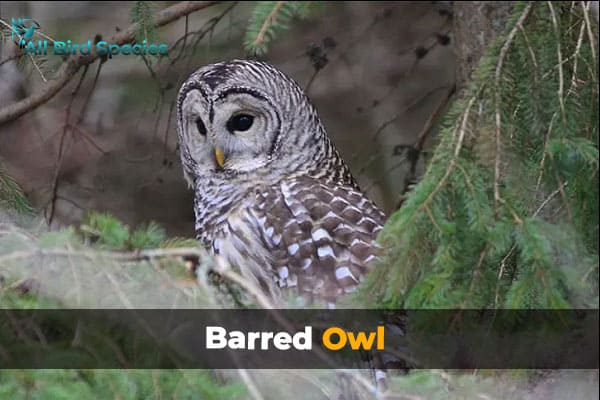
Recognizable Features
Seeing the Barred Owl up close is a treat. It has some key features that help identify it:
- Round head with no ear tufts
- Large, dark eyes that offer excellent night vision
- Bodies covered in mottled brown and gray feathers
- White streaks create a distinctive barred pattern on their chest
Common Calls and Behaviors
The Barred Owl is famous for its haunting calls. One of its main calls sounds like “Who cooks for you? Who cooks for you all?” These calls help it communicate, especially during mating season.
This owl’s behaviors are also interesting. It is often seen:
- Active hunting at dawn and dusk
- Vigilant roosting in trees to spot potential prey
- A tendency to mimic other birds’ calls to investigate their surroundings
5. Snowy Owl
The Snowy Owl is a majestic bird in the owl family. It’s known for its large size and unique look. People are drawn to its appearance and interesting way of life. Learning about Snowy Owl traits, like their movements and what they eat, helps us appreciate them more.

Identification and Appearance
The Snowy Owl is big, reaching up to 28 inches long and with a wingspan of 52 inches. It has white feathers with dark bars, making it stand out. This look helps it blend in with the snow in its summer home.
Seasonal Movements
In summer, these owls live in the Arctic. When winter comes, they move south to places like Ohio. How often they come depends on the food available. Birdwatchers enjoy seeing them fly or rest in fields during these visits.
Dietary Preferences
Their diet includes small mammals like lemmings and voles. They also eat birds, showing they are adaptable. Their hunting skills are crucial in winter when food is hard to find. This shows why knowing what they eat is important.
| Aspect | Details |
|---|---|
| Size | Up to 28 inches in length |
| Wingspan | Up to 52 inches |
| Plumage | Predominantly white with dark barring |
| Breeding Habitat | Arctic regions during summer |
| Winter Habitat | Open fields in North America |
| Main Food Source | Lemmings, voles, and birds |
| Migratory Behavior | Seasonal shifts with varying abundance |
Other Notable Owls in Ohio
Ohio is home to many owl species, each with its own unique traits and habitats. The Short-eared Owl, Northern Saw-whet Owl, and Long-eared Owl are especially notable. They attract birdwatchers and nature lovers alike.
6. Short-eared Owl

The Short-eared Owl is a medium-sized bird, about 15 inches long. It’s known for its dark eye patches and small ear tufts. You can find it in open fields and grasslands, hunting small mammals during the day.
Its home is in Ohio’s prairies and coastal areas. This makes it a great sight for those exploring the outdoors.
7. Northern Saw-whet Owl
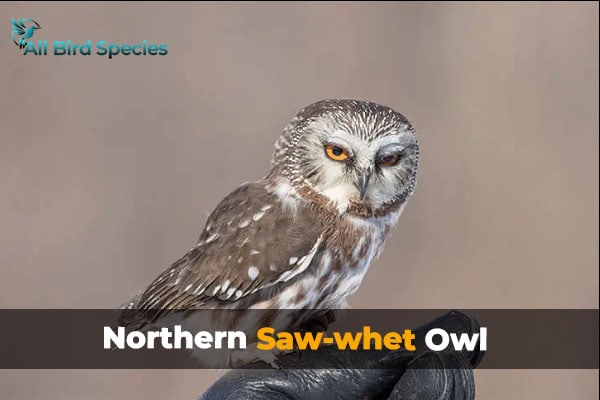
The Northern Saw-whet Owl is one of Ohio’s smallest owls, standing at 7-8 inches tall. It’s easy to miss because of its small size and big eyes. These owls live in dense forests and are hard to spot.
They like to nest in coniferous forests or thick brush. They stay hidden during the day and night, adding to their mystery.
8. Long-eared Owl

The Long-eared Owl stands out with its big ear tufts and orange eyes. It’s a beautiful sight in Ohio. These owls live in areas with lots of vegetation to hide in.
In winter, they often gather in large groups. Watching them can teach us about their social lives and how they hunt.
Conservation Status of Owls in Ohio
Ohio’s owl populations face many challenges that threaten their survival. Species like the Barred Owl and Eastern Screech-Owl are listed as “Least Concern.” But, we must keep a close eye on their numbers to tackle the threats they face.
Current Population Trends
Understanding owl population trends in Ohio is key to their conservation. Surveys provide important data. They show where owl numbers might be dropping due to habitat loss or land use changes. This info helps conservationists make better plans to help these birds.
Threats to Owl Species
Owls in Ohio face several threats that harm their homes and health. Key threats include:
- Habitat destruction: Urban growth and farming take over their natural spaces, leaving owls with less room to live and hunt.
- Human impact: Poaching and rodenticides harm owl populations, and rodenticides also harm other animals.
- Climate change: Climate shifts can change where owls find food and homes, making it harder for them to survive.
By tackling these threats with conservation efforts, Ohio can help protect its owls for the future.
| Threats | Description |
|---|---|
| Habitat Destruction | Loss of natural habitats due to urban and agricultural development. |
| Human Impact | Negative effects from poaching and rodenticides. |
| Climate Change | Altering prey availability and suitable nesting habitats. |
How to Spot Owls in Ohio
Spotting owls in Ohio is exciting, especially if you know where to look and how to act around them. Knowing the best places to watch owls and using good tips can make your birding in Ohio better. This guide will help you find these amazing birds and see them in their natural homes.
Best Locations for Viewing
To see owls, check out these top spots known for their owl populations:
- Wooded parks
- Nature reserves
- Agricultural fields
Visit early morning or dusk for the best chance to see owls. They are most active then. Going to these top spots for owl-watching with local advice can make your visit better.
Tips for Owl Watching
Here are some tips to help you watch owls successfully:
- Be patient and quiet. Owls can easily be disturbed by noise.
- Use binoculars for a closer view but keep a respectful distance.
- Listen closely for any distinctive calls; this can guide you to their location.
- Consider joining local birding groups that organize excursions to known habitats.
These simple tips can make your birding Ohio experience better and increase your chances of seeing these rare birds. Enjoy the adventure and make the most of every moment looking for owls!
Related Articles
Wrapping Up…
As we finish our look at Ohio’s owls, it’s clear this state is a paradise for owl fans. It’s home to many owl species, each with its traits and roles in nature. Learning about these birds not only broadens your knowledge but also shows why we need to protect them.
Watching owls can teach you a lot and feel rewarding. By visiting places where they live and watching them, you help spread the word about their importance. You can also help protect them by supporting conservation efforts.
To wrap up, whether you love birds or are just starting to learn, Ohio offers many ways to connect with its owls. Understanding their value in nature makes us want to help them survive and flourish in the future.

